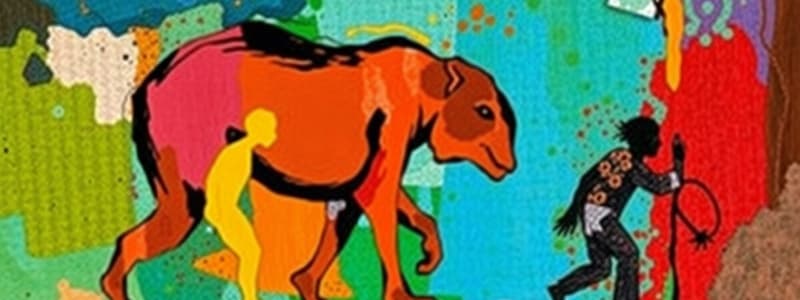Podcast
Questions and Answers
What lifestyle characterized the Upper Paleolithic Age?
What lifestyle characterized the Upper Paleolithic Age?
Hunting-gathering.
What significant change occurred during the Holocene Age around 10,000 BC?
What significant change occurred during the Holocene Age around 10,000 BC?
The transition to cattle-keeping and agriculture.
What tools did humans develop during the Mesolithic Age?
What tools did humans develop during the Mesolithic Age?
Sharp and pointed tools for hunting.
What evidence suggests early human existence in India?
What evidence suggests early human existence in India?
What was a major technological advancement during the Paleolithic Age?
What was a major technological advancement during the Paleolithic Age?
What was the main idea of Alfred Wegener's theory of continental drift?
What was the main idea of Alfred Wegener's theory of continental drift?
What does the term 'Pangaea' refer to?
What does the term 'Pangaea' refer to?
How is prehistory defined in relation to history?
How is prehistory defined in relation to history?
What is the main premise of the Radiation Theory regarding human evolution?
What is the main premise of the Radiation Theory regarding human evolution?
In which year did Alfred Wegener publish his theory of continental drift?
In which year did Alfred Wegener publish his theory of continental drift?
What significant discovery was made at Hathnora in 1982?
What significant discovery was made at Hathnora in 1982?
To which geological period does the Narmada Man date?
To which geological period does the Narmada Man date?
What genus is the Narmada Man believed to belong to?
What genus is the Narmada Man believed to belong to?
Where is Hathnora located?
Where is Hathnora located?
How does the discovery at Hathnora contrast with findings in other regions?
How does the discovery at Hathnora contrast with findings in other regions?
What is the significance of the Narmada skull in the classification of hominins?
What is the significance of the Narmada skull in the classification of hominins?
What cranial capacity range does the Narmada skull fall within, and how does it compare to Homo erectus?
What cranial capacity range does the Narmada skull fall within, and how does it compare to Homo erectus?
What age range has been estimated for the Narmada skull?
What age range has been estimated for the Narmada skull?
What are the current views on the evolutionary status of the Narmada skull?
What are the current views on the evolutionary status of the Narmada skull?
Describe the general layout and purpose of the diagram presented in the analysis.
Describe the general layout and purpose of the diagram presented in the analysis.
Flashcards
Hathnora Evidence
Hathnora Evidence
Discovery of a hominid fossil in India, placing the subcontinent on the global hominid fossil map.
Narmada Man
Narmada Man
The name given to the hominid fossil discovered at Hathnora.
Middle Pleistocene
Middle Pleistocene
Geological epoch when the Narmada Man fossil was dated.
Homo genus
Homo genus
Signup and view all the flashcards
Hominid fossil
Hominid fossil
Signup and view all the flashcards
Narmada Skull
Narmada Skull
Signup and view all the flashcards
Cranial Capacity
Cranial Capacity
Signup and view all the flashcards
Homo Erectus
Homo Erectus
Signup and view all the flashcards
Archaic Homo Sapiens
Archaic Homo Sapiens
Signup and view all the flashcards
Evolutionary Status
Evolutionary Status
Signup and view all the flashcards
Continental Drift
Continental Drift
Signup and view all the flashcards
Pangaea
Pangaea
Signup and view all the flashcards
Laurasia & Gondwanaland
Laurasia & Gondwanaland
Signup and view all the flashcards
Prehistory
Prehistory
Signup and view all the flashcards
Radiation Theory
Radiation Theory
Signup and view all the flashcards
Paleolithic Age
Paleolithic Age
Signup and view all the flashcards
Mesolithic Age
Mesolithic Age
Signup and view all the flashcards
Neolithic Age
Neolithic Age
Signup and view all the flashcards
Control of Fire
Control of Fire
Signup and view all the flashcards
Soan Valley
Soan Valley
Signup and view all the flashcards
Study Notes
Hathnora Evidence
- A true hominid fossil recently found in the Indian subcontinent
- This is in contrast to the number of such finds in eastern and southern Africa, Europe, and parts of Asia (including China, and Java in Indonesia)
- The discovery was in the Narmada valley by a geologist in 1982
- The fossil is called the Narmada Man and is from the Middle Pleistocene
Studying That Suits You
Use AI to generate personalized quizzes and flashcards to suit your learning preferences.
Description
Explore the significant milestones in prehistoric human evolution and the development of tools from the Upper Paleolithic to the Mesolithic Age. This quiz covers key concepts such as the changes during the Holocene, Alfred Wegener's theory of continental drift, and notable archaeological discoveries like the Narmada Man and Hathnora. Test your knowledge on early human existence and technological advancements!




